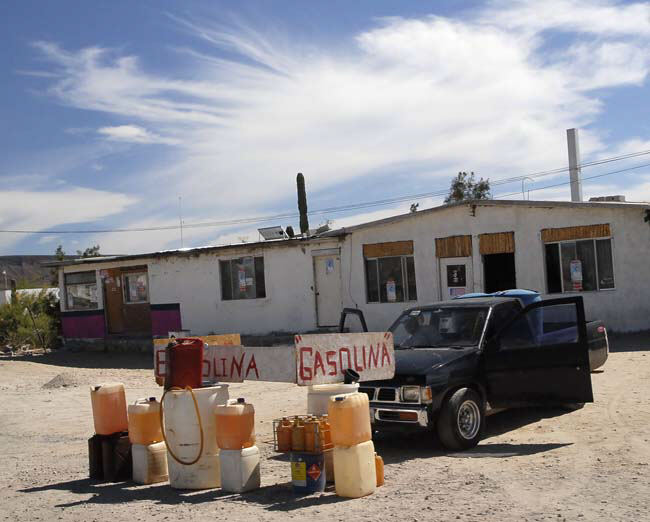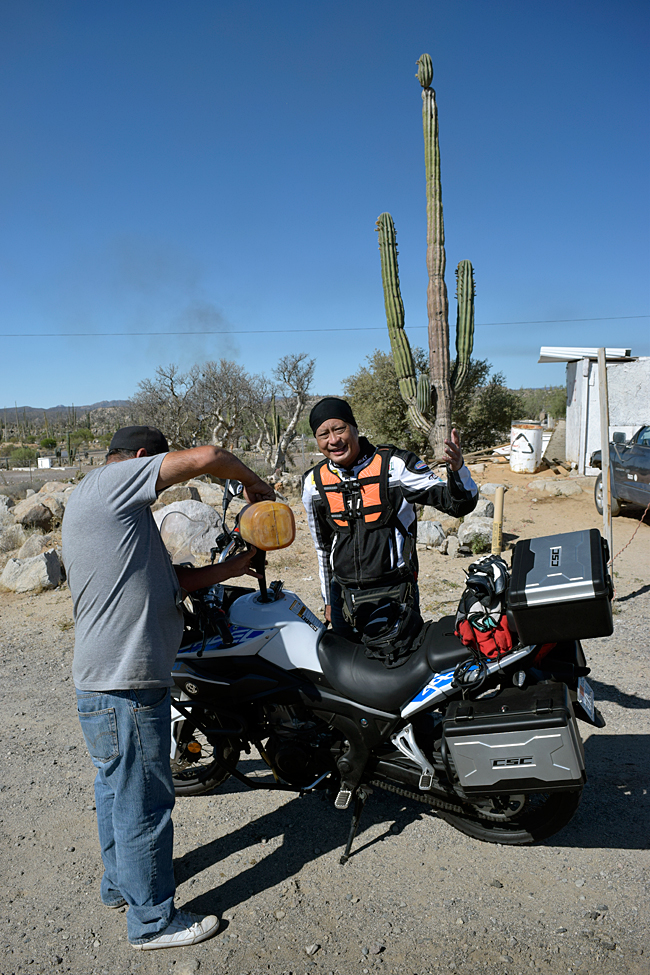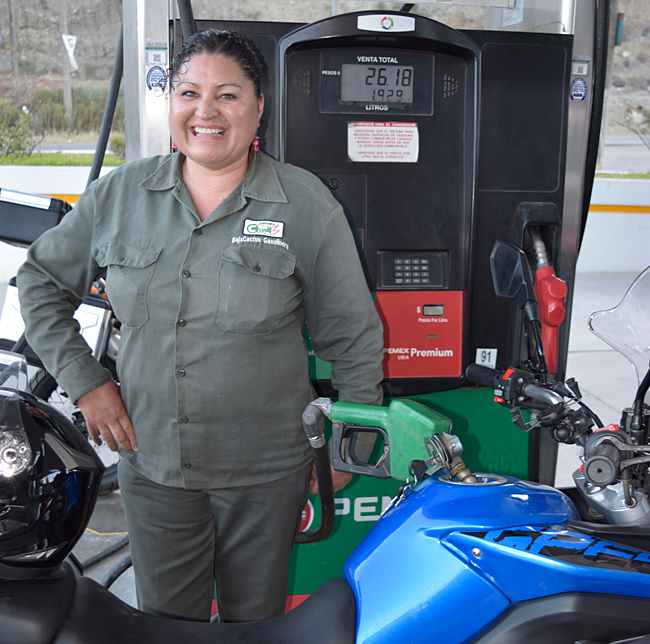
A question I sometimes hear about traveling in Baja is: What about gasoline?
Getting fuel in Mexico is pretty much about the same as getting fuel in the US. There are a few things you should know, but concerns about fuel shouldn’t hinder your plans to ride south of the border. Let’s take a look at what folks planning a Baja expedition might worry about.
Availability
Baja has gas stations distributed about like we do here in the US. There are lots of them in and around the cities, one or two in each of the smaller towns, and they are farther apart in the deserts (all similar to the situation here in America).

The only stretch where it can be concern is the long stretch through the Valle de Los Cirios between El Rosario and Guerrero Negro, where it’s a cool 200 miles (that’s miles, not kilometers) between Pemex stations. That’s beyond the range of many motorcycles’ fuel tanks, but don’t worry about it. In Catavina, which is very roughly at the midway point between these two spots, you’ll a bunch of enterprising Mexicans selling fuel in plastic jugs or pumping it out of a 55-gallon drum. Capitalism rules, folks!

There’s another plus to stopping for fuel in Catavina and buying gasolina from the guys selling it out of bottles: It makes for a great photograph!
Price
I live in California, the land of exorbitant taxation and left-wing loonies run amuck. What that means is that our gasoline prices are usually about 50% higher than what people in the more-sensibly-governed parts of the US pay. The advantage here, for me, is that the fuel prices in Baja are about the same as what I pay for gas in the Peoples Republik of Kalifornia. As of this writing, we pay somewhere around $3.25/gallon for regular, and something closer to $4.00/gallon for high test. Another thing to consider here is that you don’t buy fuel by the gallon in Baja; you buy it in liters. And the price is not in dollars; it’s in pesos. Today, it’s about 17 pesos per liter, which is about $3.39 (US) per gallon. See what I mean? The prices are roughly equivalent to California.
One more minor point: Mexico uses the dollar sign for pesos, so when you see a fuel price of, say, $17.85, that’s 17.85 pesos per liter. Use of the dollar sign for pesos is a little unnerving at first, but you’ll soon get used to it.
Paying for Fuel
Most places in the US require that you pump your own gas, and most of us pay with credit cards at the pump. You can forget about that in Baja. The way it works in Mexico is that every gas station has attendants, and they’ll do the pumping for you. They all seem to know that you’ll want to handle the nozzle when you’re on a motorcycle, but they’ll take the nozzle out of the pump, hand it to you, and then you can do the pumping.
You pay the attendants directly, too, so then the question becomes: Do you pay in dollars or pesos? I always have enough pesos that I pay directly in their currency. I’d go nuts trying to the convert the pesos to dollars in my head, and I don’t like to try screwing around with a calculator when I’m filling up, so I just pay directly in pesos. The attendants will take the cash from you and run up to the cashier if you have change coming; you don’t pay the cashiers directly.

I’ve never used a credit card at a Baja gas station. Some of them may take credit cards, but I don’t like the idea of giving my credit to somebody who’s going to run into an office to use it. I always pay in cash.
One more thing: Tipping is a good idea. Yeah, you’ll probably never see the attendant again, but it’s peanuts to us and a livelihood to them. Do the right thing, and give a few extra pesos to the person who helped you.
Fuel Brands
Until relatively recently, the government-run Pemex brand was the only fuel station in Mexico (other than the guys selling it out of bottles in places like Catavina). The story was that the government subsidized the price of fuel but did no exploration, so ultimately their fields played out. That’s when the Mexican government realized that Margaret Thatcher was right: Socialism works until you run out of other people’s money. Within the last year, Mexico started allowing Arco, Mobil, British Petroleum, and others to sell gas in Mexico, with the understanding that they had access to larger reserves and these companies would pour a portion of the profits back into exploration.
Regular or Premium?
Some stations will offer both regular and premium fuel; in the more remote parts of Baja it’s regular fuel only. I always run regular, and I’ve done so even on bikes that required premium. I’ve never had a problem doing this.
Fuel Quality
We’ve all heard the stories about bad gas in Baja. Folks, it’s all Internet rubbish. I’ve never had a problem with fuel quality in Mexico, even when buying it from the guys selling out of bottles. That said, I do sometimes carry a small container of Sea Foam just in case I get fuel with water in it, but it’s never happened. I think the last time I used the Sea Foam was when I rode my Triumph Tiger in Baja. It started running a little rough somewhere north of Santa Rosalia, so I put a little Sea Foam in the fuel tank and maybe the roughness went away. Or maybe I imagined it. The bottom line here is you can forget about fuel quality issues in Baja. It just doesn’t happen.
Restroom Availability and Cleanliness
We often stop at gas stations to use the restrooms. You might have visions of filthy, disease-laden banos, but that’s another thing that just isn’t true. Most bathrooms in Baja fuel stops are relatively clean, about the equivalent of what you might see at any gas station in the US. What is different, though, is toilet paper. There’s usually none in a Mexican gas station rest room, so it’s a good idea to bring toilet paper with you. You may or may not see a sign asking that you not flush toilet paper, but to instead deposit it in a waste basket in the stall. I guess the deal is that the sewage systems are not set up to process toilet paper. It’s counter to our custom, but it’s what they do.
So there you have it. Fuel is not an issue in Baja, and it’s certainly not a reason for being apprehensive about an adventure ride in an area that arguably offers the best riding on the planet. The cost is reasonable, it’s available about like it is in the US, the quality is good, and the photo ops are awesome.
Want to make sure you never miss an ExNotes blog post? Sign up for our email updates in the widget you see to the right (if you’re on a laptop) or at the bottom of this post (if you’re on a smartphone). We’ll never give your email to anyone else, and you’ll automatically be entered in our quarterly moto-adventure book giveaway.
Like what you read here about riding in Baja? Hey, there’s lots more where that came from! Take a look at our ExNotes Baja page!

Damn it, I want to go! Why do I have to work!
Have fun guys, I’ll be reading and plotting for my opportunity….
Damn. The TP situation is a show stopper. I feel better when my DNA is flushed. Maybe I could hold it long enough….
Jug gas at Catavina will soon be a thing of the past. They have built a Pemex station at Catavina and it is supposed to be open in March. Also, they have resurfaced the road north and south of Catavina, except for the vados on both sides of Catavina.
I prefer to buy my gas with dollars; they give you change in pesos. That’s my cerveza money. Most Pemex’s post their exchange rate which is as good as the money changers.